United States Stove 1537G User Manual
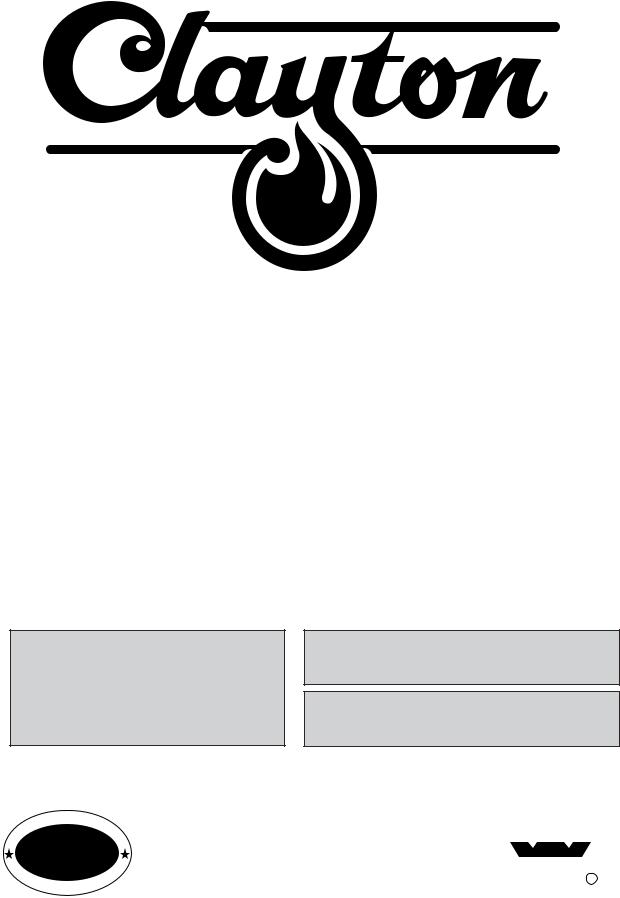
TM
Model 1537G
OWNERS MANUAL
SOLID FUEL
WARM AIR FURNACE
*FOR PARALLEL INSTALLATION WITH EXISTING FORCED AIR-GAS OR OIL FIRED FURNACE. *FOR INSTALLATION AS A CENTRAL FURNACE *THE 1537G CLAYTON FURNACE HAS BEEN APPROVED FOR U.S. INSTALLATIONS ONLY.
CAUTION:
READ ALL INSTRUCTIONS CAREFULLY BEFORE STARTING THE INSTALLATION OR OPERATING THE FURNACE
IMPROPER INSTALLATION MAY VOID
YOUR WARRANTY
DO NOT USE THIS FURNACE IN A MOBILE HOME OR TRAILER
|
|
|
|
|
TAT |
|
|
|
|
|
|
|
|
D |
S ES |
S |
|
|
|
|
I |
E |
|
|
T |
|
|||
|
|
|
|
|
|
O |
|||
|
N |
T |
|
|
|
|
|
V |
|
|
|
|
|
|
|
|
|
||
U |
USSC |
||||||||
|
|
|
|
|
|
|
|
|
E |
|
|
|
|
C |
Y |
|
|
|
|
|
|
|
|
OMPAN |
|
|
|
|
|
UNITED STATES STOVE COMPANY |
|
|
|
|
|
|
|
|
227 Industrial Park Road |
WARNOCK HERSEY |
|||||||
P.O.Box 151 |
||||||||
|
|
|
|
|
|
|
||
South Pittsburg, TN 37380 |
|
|
|
|
|
|
R |
|
|
|
|
|
|
|
|||
|
|
|
|
|
|
|||
|
|
|
|
|
|
|||
(423) 837-2100 |
|
|
|
|
|
|
||
|
|
|
|
|
|
|
||
1 |
851340 |
5/98 |

CONGRATULATIONS!
You've purchased one of America's Finest Wood and Coal Burning Furnaces. By heating with wood and coal you're helping CONSERVE AMERICA'S ENERGY! Wood is our Renewable Energy Resource. Please do your part to preserve our wood supply. Plant at least one tree each year. Future generations will thank you.
NOTE: YOUR UNIT MUST BE INSTALLED BY A
QUALIFIED FURNACE INSTALLER.
TOOLS AND MATERIALS NEEDED
TOOLS |
MATERIAL |
Pencil |
6" Pipe, 6" Elbow, Collar and Thimble; |
6 Foot Folding Rule or Tape |
as required (24 gauge min.) |
Tin Snips |
1/2" Sheet Metal Screws |
Drill, Hand or Electric |
6" Inside diameter Listed Residential |
Drill Bit- 1/8" Dia. |
Type or Building Heating Appliance |
(For Sheet Metal Screws) |
Chimney or existing masonry chimney |
Screw Driver (Blade-Type) |
Electrical Wiring |
Gloves |
6" Draft Regulator |
Sabre Saw |
1/2" Conduit (Conduit Connectors) |
5/16" Nut Driver or |
Furnace Cement (Manufacturer |
5/16" Socket w/Ratchet |
Recommends: Rutland Black-Code 78 |
|
or Equivalent) |
|
Plenum and Duct work as required. |
2
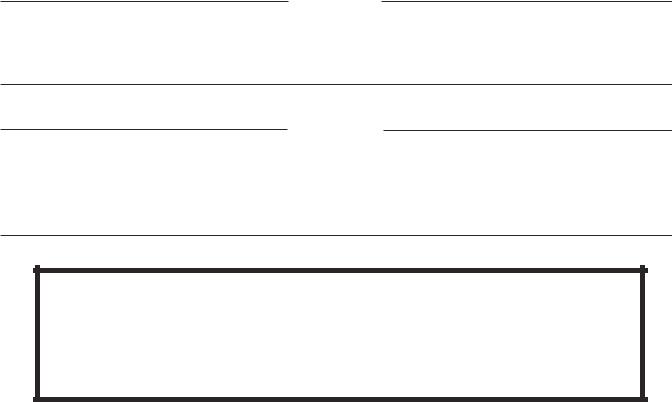
CAUTION LABELS
Your Furnace has the following labels. Read and Obey all labels.
DANGER: RISK OF FIRE OR EXPLOSION.
DO NOT burn garbage, gasoline, drain oil, or other flammable liquids.
WARNING: FIRE HAZARD.
DO NOT operate with fire draft exceeding .06 inches w.c.
DO NOT operate with fuel loading or ash removal doors open.
DO NOT store fuels, paints, thinners, flammable liquids, or other highly volatile substances in the furnace room.
CAUTION: HOT SURFACES
Keep children away.
Do not touch during operation.
CAUTION!
INSPECT FLUE PIPES, FLUE PIPE JOINTS AND FLUE PIPE SEALS REGULARLY TO ENSURE THAT SMOKE AND FLUE GASES ARE NOT DRAWN INTO, AND CIRCULATED BY, THE AIR CIRCULATION SYSTEM.
CAUTION!
CLEANOUT OF THE HEAT EXCHANGER, FLUE PIPE, CHIMNEY, AND DRAFT INDUCER (IF USED), IS ESPECIALLY IMPORTANT AT THE END OF THE HEATING SEASONTO MINIMIZE CORROSION DURINGTHE SUMMER MONTHS, CAUSED BY ACCUMULATED ASH.
SAFETY NOTICE: If this heater is not properly installed, a house fire may result. For your safety, follow the installation directions. Contact local building or fire officials about restrictions and installation inspection requirements in your area.
3
RULES FOR SAFE INSTALLATION AND OPERATION
Read these rules and the instructions carefully. Failure to follow them will cause a hazard that could result in death, serious bodily injury, and/or property damage.
1.Check your local codes. The installation must comply with their rulings.
2.Do not install this furnace in a mobile home or trailer.
3.Always connect this furnace to a chimney and vent to the outside. Never vent to another room or inside a building.
4.Do not connect this furnace to an aluminum Type B gas vent. This is not safe and is prohibited by the National Fire Protection Association Code. This furnace requires a masonry or Listed Factory Built Chimney for residential type or Building Heating Appliance
Chimney. Use a 6" diameter chimney or larger, that is high enough to give a good draft. (See page 7)
5.Be sure that if a masonry chimney is used, it is safely constructed and in good repair. Have the chimney inspected by the Fire Department or an inspector.
6.Inspect chimney connector and chimney before and frequently during the heating season for any deposit of creosote or soot which must be removed (See Chimney Maintenance, page 15).
7.Provide air for combustion into the room where the furnace is located. If the intake is not in the same room, air must have free access to the room.
8.CAST IRON PARTS MUST BE "SEASONED" TO AVOID CRACKING, BUILD ONLY SMALL FIRES ON FIRST USE.
9.To prevent injury, do not allow anyone to use this furnace who is unfamiliar with the correct operation of the furnace.
10.For further information on using your furnace safely, obtain a copy of the National Fire
Protection Association (NFPA) publication "Chimney's, Fireplaces and Solid Fuel Burning Appliances" NFPA 211. The address of the NFPA is Batterymarch Park, Quincy, MA 02269.
11.Keep the ashpit section free of excess ashes. Do not allow ashes to stack higher than the sides of the ash pan.
12.DISPOSAL OF ASHESPlace ashes in a metal container with a tight fitting lid. Keep the closed container on a noncombustible floor or on the ground, well away from all combustible materials. Keep the ashes in the closed container until all cinders have thoroughly cooled. The ashes may be buried in the ground or picked up by a refuse collector.
13.CAUTIONThe special paints used on your furnace may give off some smoke while they are curing during first few fires., Build small fires at first. The metal used in construction of the furnace and duct work has a light coating of oil. This could give off smoke and/or odor from registers when furnace is used for the first time. This should disappear after a short period of time. Once this burn-off has occurred, it should not reoccur.
14.CARING FOR PAINTED PARTSThis furnace has a painted outside jacket, which is durable, but it will not stand rough handling or abuse. When installing your furnace, use care in handling. Clean with soap and warm water when furnace in not hot. DO NOT use any acids or scouring soap, as these wear and dull the finish. DISCOLORATION WILL OCCUR
IF THE FURNACE IS OVERHEATED. FOLLOW OPERATING INSTRUCTIONS
CAREFULLY.
Your Furnace is designed to be installed in a parallel air flow arrangement with a gas or oil-fired forced air upflow-type central furnace, or it may be installed as a central furnace.
4
HOW THE FURNACE FUNCTIONS
Your CLAYTON Furnace is designed to be a supplemental or central heating source for your home. This Solid Fuel Furnace may be installed in conjunction with a properly operating central furnace that is listed or certified in accordance with nationally recognized safety standards and equipped with the required controls and other safety features and which has been installed in accordance with appropriate standards of the National Fire Protection Association with installation clearances specified in the furnace nameplate marking. The installation must be accomplished by a qualified agency (one who is engaged in, and is responsible for, or is thoroughly familiar with the installation and operation of the gas, oil, and solid fuel burning heating appliances, who is experienced in such work, familiar with all the requirements of the authority having jurisdiction.) The installation shall be in strict accordance with the manufacturer's installation instructions furnished with the solid fuel furnace.
The chimney connector of the furnace is to be installed to provide clearances to combustible material not less than specified in the individual classifications and marked on the furnace. The chimney connector must be connected to a chimney suitable for use with residential type or building heating appliances which burn solid fuel.
The Furnace is designed to operate in either parallel or series air flow arrangement with the central furnace or as a central furnace.
CENTRAL FURNACE INSTALLATION: As a central furnace, the unit functions independently of any other system. The blower will come on when the plenum temperature reaches the setting on the blower control.
PARALLEL INSTALLATION: (U.S. ONLY)
(See Optional Wiring Diagram, Page 13, Fig. 14) The design is such that when the blower comes on, the blower on the central system also comes on. The blower will only come on when the temperature in the plenum has reached the setting on the blower control. This is to insure that there is sufficient warm air in the system to make it efficient for the unit to operate. When the central system thermostat calls for heat, the central system will operate by the burner igniting and the blower coming on. It is possible that both systems will operate simultaneously. It is recommended that for the most efficient use of your CLAYTON
Furnace, that it be fired as much as possible in order to reduce the demand on your existing central heating system. This unit has an optional forced draft kit that operates from a wall thermostat. When the temperature falls below the setting on the wall thermostat, the forced draft will come on (U.S. Stove Option 11/DKU)
The warm air supply outlet of the CLAYTON
Furnace shall not be connected to the cold air return of the central furnace, because the possibility exists of components of the central furnace overheating and causing the central furnace to operate other than is intended.
5
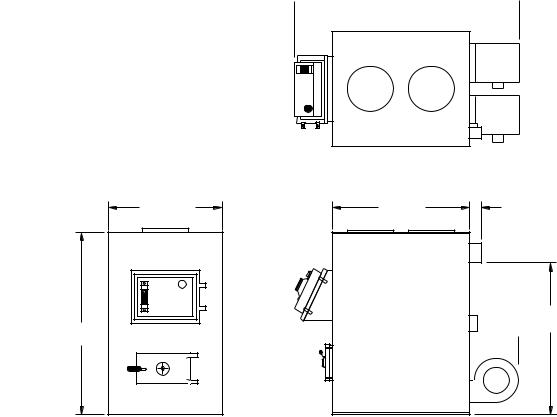
DIMENSIONS OF FURNACE
 49-1/8"
49-1/8" 
FIGURE 1
1537G
Figure 1B 1400/1500
24-1/16" |
32-1/8" |
1-3/4" |
33-7/8"
40-11/16"
 9"
9"
6
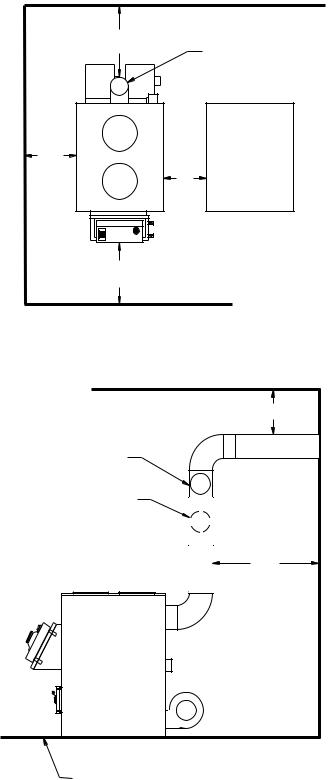
LOCATING THE FURNACE
1.The furnace should be located in the same room as the central system and as close as possible, but not closer than 9". There should be no wall between the furnace and the warm air outlet duct that is connected directly to the warm air outlet plenum of the central furnace. (See Fig. 2)
2.The unit will require installation with the following clearances:
Unit to sidewall............... |
12"(305mm) |
Unit to backwall............ |
30"(760mm) |
Chimney connector pipe to sidewall
.....................................21"(530mm) Chimney connector pipe to backwall
.....................................18"(460mm) Hot air ducts to combustibles
.......................................6"(150mm) (Refer to Fig. 2 & 3)
3.Place the furnace on a noncombustible floor.
4.Check figures 2 and 3. Be sure you have the clearances shown from the furnace and the connector pipe to combustible surfaces. If you have a solid brick or stone wall behind your furnace, you can place the furnace as close as you wish to the wall. If the wall is only faced with brick or stone, treat it as a combustible wall.
18"
6" CHIMNEY
12" |
9" |
CENTRAL |
|
FURNACE |
|||
|
|
48"
Figure 2
18" |
6" SOLID DAMPER |
6" BAROMETRIC |
DRAFT REGULATOR |
(OPTIONAL) |
18" |
NON-COMBUSTIBLE FLOOR
Figure 3
7
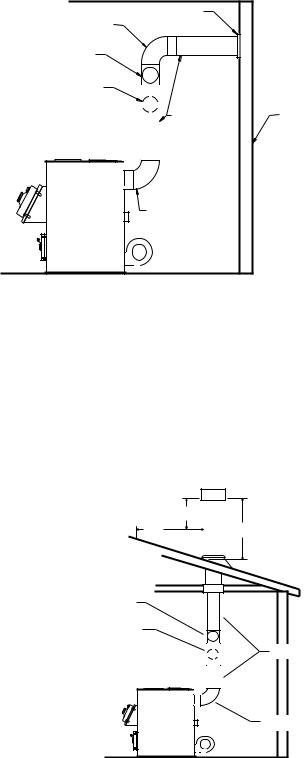
CHIMNEY CONNECTION
MASONRY CHIMNEY
|
THIMBLE |
|
6" ELBOW |
|
|
6" SOLID DAMPER |
|
|
6" BAROMETRIC |
|
|
DRAFT REGULATOR |
|
|
(OPTIONAL) |
6" CHIMNEY |
NON-COMBUSTIBLE |
|
CONNECTOR |
WALL |
|
6" ELBOW |
|
|
|
Fig. 4 |
Before using an existing masonry chimney, clean the chimney and inspect the flue liner to be sure it is safe to use. Make repairs before attaching the furnace. See page 4, item 5. Look at Fig. 4. The connector pipe and fittings you will need to connect directly to a masonry chimney are shown.
The chimney connection should be as short as possible.
If the connector pipe must go through a combustible wall before entering the masonry chimney, consult a qualified mason or chimney dealer. The installation must conform to local fire codes, and
N.F.P.A. 211.
DO NOT CONNECT THIS FURNACE TO A CHIMNEY FLUE SERVING ANOTHER APPLIANCE.
The chimney used for a furnace must not be used to ventilate the cellar or basement. If there is a cleanout opening at the base of the chimney, close it tightly.
|
|
|
REFER TO CHIMNEY |
2' MIN. |
|
|
|
|
|
MANUFACTURER'S |
|
10' |
|
3' MIN. |
INSTRUCTIONS AND |
|
PARTS. |
||
|
|
|
|
|
|
|
|
Fig. 5
6" SOLID DAMPER |
|
6" BAROMETRIC |
|
DRAFT REGULATOR |
|
(OPTIONAL) |
6" CHIMNEY CONNECTOR |
6" ELBOW |
LISTED FACTORY BUILT CHIMNEY
Carefully follow chimney manufacturer's instructions. Use only a Listed Residential Type or
Building Heating Appliance Chimney. If your chimney starts at the ceiling (Fig. 5), you will need enough 6" pipe to reach the ceiling.
The top of the chimney must be at least 3 feet above the roof and be at least 2 feet higher than any point of the roof within 10 feet (Fig. 5).
8
